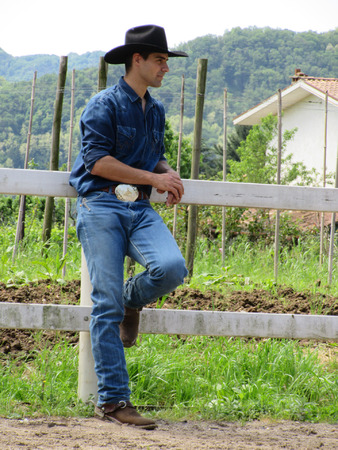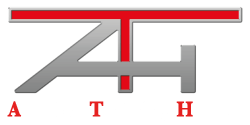ATH METHOD
The steps of the communication with the horse

The ATH method has been developed combining techniques learned from national and international trainers and horsemen, with the experience gained on many dozens of horses of any breed and from all walks. At the ATH method base there’s a solid foundation of control and respect, that are two sides of a coin. We cannot get the control if we don’t have the respect and we cannot gain the respect without control. Control and respect contribute to then gain the trust of the horse. The groundwork is the key to gain a direct line of communication with the animal, in order to understand the issues and begin the resolution, as well as build the foundations of the following saddle work.
Amedeo Ramazzotto
Horseman e trainer
ATH borns in 2012, when Amedeo devote himself completely to the world of the horse and the training, leaving the solid position of Accounting Manager in a middle sized metalworking company. The experience at the Buffalo Ranch in Texas convinces him to pursue a journey of knowledge in the communication of those magnificent animals. Soon came another experience in Selah Ranch, again in Texas, where the colts starting was a daily operation. These experiences, with the meeting with some famous trainers, lays the foundation of a all-around horses training method, from the reining to the cow horse, from trailhorse to the team penning, from a jumping to the dressage horse and to the ricreational horses. The problematic horses challange purses him to offer clinics on the equine technique improvement and on the developement of the human being-horses relationship, through the ATH method.
when Amedeo devote himself completely to the world of the horse and the training, leaving the solid position of Accounting Manager in a middle sized metalworking company. The experience at the Buffalo Ranch in Texas convinces him to pursue a journey of knowledge in the communication of those magnificent animals. Soon came another experience in Selah Ranch, again in Texas, where the colts starting was a daily operation. These experiences, with the meeting with some famous trainers, lays the foundation of a all-around horses training method, from the reining to the cow horse, from trailhorse to the team penning, from a jumping to the dressage horse and to the ricreational horses. The problematic horses challange purses him to offer clinics on the equine technique improvement and on the developement of the human being-horses relationship, through the ATH method.
8 STAGES FOR THE ATH METHOD
The ATH method divided into stages for an easier application and and easier learning
Basic level
Groundwork
1 – THE BASICS
#1 – Basic control
#2 – Stop and change of direction
#3 – The attention
2 – THE BASIC RESPECT
#4 – The rationalization
#5 – The halter respect
#6 – The personal space
3 – THE BASIC CONTROL
#7 – The hind quarter control
#8 – The shoulder control
#9 – Side-pass
#10 – Back-up
4 – CONTROL AND RESPECT EXERCISES
#11 – Move your shoulders
#12 – The corridor
#13 – The remote control
Saddlework
5- BEFORE MOUNTING
#14 – Bit respect
#15 – Acceptance of the rider
6 – CONTROL FROM THE SADDLE
#16 – Mouth control
#17 – Neck control
#18 – Legs respect
#19 – Shoulders control
#20 – Hind quarters control
7 – BASIC MANEUVERS
#21 – Turns and lightness
#22 – Transitions
#23 – Collection
#24 – The stop
#25 – The correct lead
#26 – The spin
#27 – The pivot on the hind quarters
8- ADVANCED MANEUVERS
#28 – Side-pass and leaning
#29 – Counter-canter work
#30 – Circles
#31 – The straight line
#32 – Lead changes
8 STAGES FOR THE ATH METHOD
Intermediate level
Groundwork
1 – INTERMEDIATE EXERCISES OF RESPECT
#1 – Shift at the touch
#2 – Rationalization in motion
2 – INTERMEDIATE CONTROL EXERCISES
#3 – The transitions management
#4 – Stop with disengagement of the hind quarter
#5 – 360 with departure
#6 – The half moon
#7 – Connecting exercise with the halter
#8 – Flexed back up
3 – REVERSED EXERCISES
#9 – The hind quarter yielding
#10 – The shoulders yielding
#11 – Side-pass
4 – TRAILER LOADING
#12 – The control on the trailer
#13 – Working on a platform
#14 – The 3 types of loading
Saddlework
5 – VERIFICATION EXERCISES
#15 – Connecting exercise with the snafflebit
#16 – Rationalization with the rider on
6 – INTERMEDIATE CONTROL EXERCISES
#17 – Checking the giving to the bit
#18 – Checking the leg respond
#19 – Two-track exercise
#20 – Handbrake
#21 – Flexed back up
7 – COLLECTING EXERCISE
#22 – Leg collection
#23 – The collection on transitions
#24 – The half stop
#25 – The longitudinal stretch
8 – THE BIT
#26 – The one-handed horse
#27 – Collecting with the bit
9 – INTERMEDIATE MANUEVERS
#28 – The rythm on the gaits
#29 – Loping departures
#30 – Rollbacks
#31 – Reverse loping
#32 – Flying change leads

